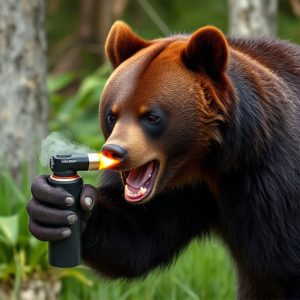Bear Spray Effectiveness & Legal Status: A Comprehensive Guide
Bear spray, a mixture of capsaicin from chili peppers in aerosol form, is a non-restricted self-defe…….
Bear spray, a mixture of capsaicin from chili peppers in aerosol form, is a non-restricted self-defense tool for outdoor enthusiasts in areas with bears. It deters aggressive bears by irritating their eyes and respiratory system, allowing users to create distance and escape safely. While effective, correct application techniques are crucial, as bear spray isn't foolproof against large, aggressive bears. Its legal status varies globally, but it's generally available without special licensing. Responsible usage, including understanding range, wind conditions, and maintaining distance, is essential for its effectiveness. Training sessions simulating real-world scenarios enhance protection during encounters with charging bears or other unpredictable wildlife.
“Uncovering the effectiveness of bear spray as a defense mechanism against aggressive bears, this article offers a comprehensive guide. Bear spray, a pepper-based aerosol, has gained popularity as a non-lethal deterrent. While its legality varies, understanding its composition and mechanism is key to effective usage. We explore scientific insights into its success against charging bears, dispel myths, and provide tips for safe handling. Is bear spray a restricted weapon? Let’s navigate this topic and equip you with knowledge for wild encounters.”
- Understanding Bear Spray: Composition and Mechanism
- Effectiveness Against Charging Bears: Scientific Insights
- Legal Status and Restrictions: Is It a Restricted Weapon?
- Safe Usage and Training: Maximizing Protection in the Wild
Understanding Bear Spray: Composition and Mechanism
Bear spray, also known as bear repellent, is a crucial tool for hikers, campers, and anyone venturing into bear country. It’s not considered a restricted weapon but rather a defense mechanism designed to deter aggressive bears when used correctly. The composition of bear spray varies, typically consisting of capsaicin, the active ingredient found in chili peppers, combined with other chemicals to create an effective aerosol.
When a bear is confronted with this spray, it irritates the bear’s eyes, nose, and respiratory system, temporarily disorienting and driving away the bear. The mechanism relies on creating enough distance between the user and the bear, allowing for safe escape rather than outright killing or injuring the animal. Understanding these aspects highlights why bear spray is an essential component of bear safety protocols, especially in regions where bear encounters are common.
Effectiveness Against Charging Bears: Scientific Insights
Bear spray, also known as bear repellent, has been widely recognized as an effective tool to deter and defend against charging bears in various outdoor scenarios. Scientific studies have delved into its mechanisms and efficacy, providing valuable insights into how this aerosolized solution works. The primary active ingredient in bear spray is typically capsaicin, the same compound responsible for the heat sensation in chili peppers. When sprayed directly into a bear’s eyes and face, capsaicin irritates these sensitive areas, causing the bear to react instinctively by turning away or retreating.
Research suggests that bear spray can be highly effective against aggressive bears, especially when used appropriately. A 2015 study by the Journal of Wildlife Management analyzed multiple incidents involving grizzly bears and black bears, finding that properly applied bear spray resulted in a significant reduction in attack rates compared to other methods. However, it’s essential to note that bear spray is not a guaranteed solution, especially if used incorrectly or against particularly large and aggressive bears. Proper usage involves aiming for the bear’s face and eyes while maintaining a safe distance, ensuring it’s considered a non-restricted weapon for personal defense in many regions.
Legal Status and Restrictions: Is It a Restricted Weapon?
Bear spray, also known as bear repellent, is a popular self-defense tool for those venturing into bear country. While its effectiveness in deterring and stopping charging bears has been well-documented, there’s a common question that arises: Is bear spray considered a restricted weapon?
The legal status of bear spray varies across different jurisdictions, but it’s important to note that it is not universally classified as a restricted or controlled weapon. In many countries and regions, bear spray is available for purchase and use by the general public without needing a special license or permit. However, certain areas may have restrictions on the type, amount, and storage of bear spray, especially in national parks or wilderness reserves. It’s crucial for users to check local regulations before heading into bear-infested areas to ensure compliance and avoid any legal repercussions.
Safe Usage and Training: Maximizing Protection in the Wild
Bear spray, while often considered a crucial tool for protection against charging bears, should be used responsibly and with proper training. It’s important to note that bear spray is not a restricted weapon but rather a legal means of self-defense in many outdoor activities. However, its effectiveness depends on correct usage. Users must understand the spray’s range, wind conditions, and the appropriate distance to keep from the bear. Training sessions should cover these aspects, ensuring individuals can make quick decisions in high-stress situations.
Regular practice in simulated scenarios helps maximize protection in the wild. This includes learning how to properly hold and activate the spray canister, as well as understanding the different types of bear behaviors and when to use the spray. Remember that bear spray is a supplement to safety precautions like making noise while hiking, avoiding known bear habitats, and properly storing food. In terms of maximizing protection, training ensures individuals are prepared not just for charging bears but also for other unpredictable wildlife encounters.
Bear spray, while an effective deterrent against charging bears, is a topic that extends beyond individual safety. The legal status of bear spray as a restricted weapon varies globally, highlighting the importance of understanding local regulations. As our use of outdoor spaces expands, especially in regions with bear populations, responsible usage and training become paramount. By familiarizing ourselves with the composition, effectiveness, and safe handling of bear spray, we can better navigate potential encounters and ensure both personal safety and compliance with legal requirements, such as whether bear spray is considered a restricted weapon in our area.


